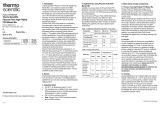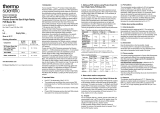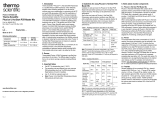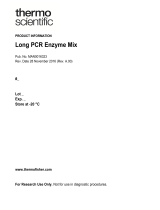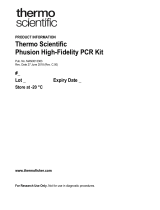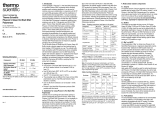Page is loading ...

1. Introduction
Thermo Scientific Phusion RT-PCR Kit is a complete kit designed for
performing cDNA synthesis and PCR in two steps using RNA as a
starting template. The kit includes all the necessary reagents for both
cDNA synthesis and DNA amplification.
In the cDNA synthesis step, RNA is transcribed by Moloney
Murine Leukemia Virus Reverse Transcriptase (M-MuLV RT) to its
complementary DNA (cDNA). Examples of RNA that may be used as
a starting material are total RNA, mRNA, viral RNA, as well as in
vitro transcribed RNA. The reverse transcriptase utilized in this kit has
intrinsic RNase H activity. This simplifies the cDNA synthesis protocol
as it renders a separate RNase treatment step unnecessary. For the
subsequent amplification of the cDNA template, Phusion® Hot Start
II High-Fidelity DNA Polymerase is provided. It is a proofreading DNA
polymerase providing extreme processivity, accuracy and specificity
in the amplification step.
2. Kit components
Component Concentration F-546S F-546L
RT enzyme mix
(M-MuLV RNase H+ RT
+ RNase inhibitor)
1 x 40 µl 1 x 200 µl
10x RT Buffer (includes
50 mM MgCl2*)
1 x 1.5 ml 1 x 1.5 ml
Oligo(dT)15 primers 100 ng/µl 1 x 20 µl 1 x 100 µl
Random primers (hexamers) 50 ng/µl 1 x 20 µl 1 x 100 µl
dNTP Mix 10 mM 1 x 40 µl 2 x 100 µl
Phusion Hot Start II
DNA Polymerase
2U/µl 1 x 10 µl 1 x 50 µl
5x Phusion HF Buffer 1 x 1.5 ml 1 x 1.5 ml
Control RNA with carrier 10 ng MS2 RNA/µl 1 x 20 µl 1 x 20 µl
Control primer mix 25 µM each 1 x 20 µl 1 x 20 µl
* Provides 5 mM MgCl2 in 1x reaction concentration.
Material safety data sheet (MSDS) is available at www.thermoscientific.com/
fzmsds.
3. General considerations
3.1 cDNA synthesis
3.1.1 RNA template
The integrity and purity of the isolated RNA is crucial for a successful
RT-PCR. Therefore, special attention should be paid when isolating
the RNA template to ensure that it is free of any contaminating RNase
and DNA. To avoid RNase contaminants, RNA isolation should be
performed under RNase-free conditions. This can be done by wearing
gloves and using sterile tubes and pipet tips. Examples of potential
sources for RNase contamination could be glassware, plasticware,
or reagent solutions. Water used for the reactions should be RNase-
free; however, DEPC treated water is not recommended because
traces of DEPC can inhibit the PCR step. Contaminating DNA in the
RNA preparation may be removed by RNase-free DNase I treatment.
This should be done especially if primers for the PCR step cannot be
designed in exon-exon boundaries or in separate exons. The purity
of RNA can be determined by measuring the ratio of A260/A280. The
optimal ratio is 1.8–2.0.
3.1.2 M-MuLV RNase H+ Reverse Transcriptase
M-MuLV RNase H+ (plus) Reverse Transcriptase (M-MuLV RT) used for
cDNA synthesis in this kit is an RNA-directed DNA polymerase. This
enzyme can synthesize a complementary DNA strand initiating from a
primer using either a single-stranded RNA or a single-stranded DNA
as a template. The RNase H activity in the enzyme degrades RNA in
the RNA-cDNA hybrid. This simplifies the RT-PCR protocol because,
due to the RNase H activity, it is unnecessary to perform a separate
RNase treatment step after cDNA synthesis.
3.1.3 RNase inhibitor
M-MuLV RT enzyme mix contains an RNase inhibitor. Its function
is to inhibit contaminating RNases that may be present in the RNA
preparation. It does not affect the intrinsic RNase H activity of the
M-MuLV RT.
F-546S, 20 reactions (cDNA synthesis in 20 µl, PCR in 50 µl)
F-546L, 100 reactions (cDNA synthesis in 20 µl, PCR in 50 µl)
3.1.4 RT primers
Oligo(dT) primers, random primers, or gene-specific primers can
be used for the RT step. Oligo(dT) primers and random primers are
useful if several different amplicons need to be analyzed from a
small amount of starting material. Gene-specific primers transcribe
only specific sequences; in some cases their use may decrease
background signal.
Use of oligo(dT) primers is recommended over random primers
and gene-specific primers when using this kit. Oligo(dT) primers
transcribe poly(A)+ RNAs. These include eukaryotic mRNAs and
retroviruses with poly(A)+ tails. For amplicons that are located at
the 5’ end of the transcript, and for transcripts that do not contain
a poly(A)+ tail, it is recommended to use random primers. Random
primers are used to transcribe all RNA, producing cDNA, thereby
covering the whole transcript. To obtain optimal results, especially
with long amplicons, the ratio of RNA and random primers may
require optimization. Gene-specific primers are used to transcribe
only the particular RNA of interest.
3.2 PCR
3.2.1 DNA polymerase
The DNA polymerase included in the Phusion RT-PCR Kit is Phusion
Hot Start II High-Fidelity DNA Polymerase. It is a proofreading DNA
polymerase that contains a unique processivity-enhancing domain.
This domain makes the enzyme extremely processive, accurate and
rapid. The error rate for Phusion Hot Start II DNA Polymerase (4.4 x 10-7
as determined with a modified lacI-based method1) is approximately
52-fold lower than that of Thermus aquaticus DNA polymerase.
Phusion Hot Start II DNA Polymerase utilizes a reversibly binding
Affibody® protein.2,3 This protein inhibits DNA polymerase activity
at ambient temperatures, thus inhibiting the amplification of non-
specific products. In addition, the Affibody protein blocks the 3’→5’
exonuclease activity of the polymerase preventing degradation of
primers and template DNA during reaction setup. At polymerization
temperatures, the Affibody protein dissociates from the polymerase,
rendering the enzyme fully active.
Phusion Hot Start II DNA Polymerase possesses the following
activities: 5´→3´ DNA polymerase activity and 3´→5´ exonuclease
activity. When cloning fragments amplified with Phusion Hot Start
II DNA Polymerase, blunt end cloning is recommended. If TA cloning
is required, it can be performed by adding A overhangs to the
blunt PCR product with Thermo Scientific Taq DNA Polymerase, for
example. However, before adding the overhangs it is very important
to remove all Phusion Hot Start II DNA Polymerase by purifying
the PCR product carefully. Any remaining Phusion Hot Start II DNA
Polymerase will degrade the A overhangs, creating blunt ends again.
A detailed protocol for TA cloning of PCR fragments amplified with
any of the Phusion DNA Polymerases can be found on website: www.
thermoscientific.com/pcrcloning.
3.2.2 cDNA template
The cDNA synthesis reaction mixture may be used directly as a source
for template in the PCR reaction. Prior purification of the cDNA is not
required. The volume of the cDNA reaction mixture used should not
exceed 10 % of the final PCR reaction volume. Elevated volumes of
template may reduce the efficiency of the DNA amplification. Usually,
1–5 µl or less of the cDNA synthesis reaction mixture is sufficient in
a 50 µl PCR reaction.
3.2.3 PCR primers
Careful primer design is important in order to minimize non-specific
primer annealing and formation of primer-dimers. PCR primers should
be designed to anneal to sequences in two exons on opposite sides
of the intron. This design enables differentiation by size between
amplified cDNA and contaminating genomic DNA. Very long introns
prevent amplification of the genomic target. Alternatively, primers
can be designed to anneal to the exon-exon boundary of the mRNA.
With such primers, amplification of genomic DNA will be highly
inefficient.
Always use the Tm calculator and instructions on website: www.
thermoscientific.com/pcrwebtools to determine the Tm values of
primers and optimal annealing temperature.
4. Protocol for cDNA synthesis
4.1 Guidelines for reverse transcription
• UseglovesandRNase-freeplasticwaretopreventRNase
contamination.
• Preparepremixestoavoidpipettingverysmallvolumes.
• Pipetallcomponentsonice.
• ReactionvolumeincDNAsynthesisis20µl.
• Useupto1µgofRNAtemplate.Theminimumamountdepends
on both the template and the primers used.
• Recommendedprimeramountsina20µlreaction:
- 100 ng oligo(dT) primers (can be increased up to 1 µg) or
- 50 ng random primers (may require optimization) or
- 5 pmol (2–10 pmol) gene-specific primers.
Note: When determining the amount of RNA template, the expression
level of the target RNA molecule should be considered, as it affects
the subsequent PCR step. The volume of the cDNA reaction mixture
used as a source for template in PCR should not exceed 10 % of the
final PCR reaction volume. A high RNA concentration in the PCR may
also inhibit the reaction.
4.2 Protocol
It is recommended that control reactions be performed in parallel with
all experiments. Control RNA and primers are provided with the kit.
The setup for controls is given in chapter 6.
1. Thaw template RNA, 10x RT buffer, dNTPs and primers. Mix the
individual solutions to assure homogeneity and centrifuge briefly
before pipetting.
2. Combine the following components in reaction tubes
Template RNA x µl (up to 1 µg)
10 mM dNTP mix 1 µl
Oligo(dT) primer* 1 µl
RNase-free H2O Add to 10 µl
* Alternatively, random primers (1 µl of the 50 ng/µl stock, provided with the
kit), or gene-specific primers (volume depends on the concentration of the
primer stock) can be used. See 4.1.
Thermo Scientific
Phusion RT-PCR Kit
Product Information
Store at -20°C
3. Incubate at 65°C for 5 minutes to predenature the RNA.
4. Place the reaction tubes on ice and add to each tube
10x RT buffer 2 µl
RT enzyme mix 2 µl
RNase-free H2O 6 µl
5. Program a thermal cycler as outlined in Table 1.
6. Place the tubes in the cycler and start the program.
Table 1. Cycler protocol for cDNA synthesis.
Step Temperature Time
Primer extension 25°C 10 min
cDNA synthesis 40°C 30 min
Reaction termination 85°C 5 min
Cooling of the sample 4°C Hold
4.3 Notes about cDNA synthesis conditions
4.3.1 Predenaturation
A separate RNA denaturation step is recommended. The denaturation
step “5 minutes at 65°C” should be performed before adding the RT
buffer and reverse transcriptase to the reaction.
4.3.2 Primer extension
The incubation for 10 minutes at 25°C extends oligo(dT) and random
primers before the actual cDNA synthesis. Without the incubation
at 25°C, the primers may dissociate from the template when the
temperature is increased. When using gene-specific primers, this
extension step is not necessary.
4.3.3 cDNA synthesis
Incubation at 40°C will work for most templates, but the incubation
temperature can be optimized between 37–48°C, if necessary.
Increasing the temperature can be helpful if the template has
strong secondary structures. A higher temperature can also improve
specificity if gene-specific primers are used. Incubation above 48°C
is not recommended.
In most cases, incubation for 30 minutes is sufficient. If the target is
located near the 5’ end of a long transcript and oligo(dT) priming is
used, or if the target is rare, cDNA synthesis time can be extended
up to 60 min.
4.3.4 Reaction termination
The termination step at 85°C inactivates the M-MuLV RT. This prevents
the reverse transcriptase from inhibiting the subsequent PCR reaction.
Note: A separate RNase H treatment is not required. The cDNA can be
directly used as a template in the subsequent PCR or stored at -20°C,
if not used immediately.
5. Amplification of the cDNA template
5.1 Guidelines for PCR
• Carefullymix and centrifuge alltubes before opening toensure
homogeneity and improve recovery.
• PCRsetupcanbedoneatroomtemperature.
• Prepareamastermixfortheappropriatenumberofsamplestobe
amplified.
• The DNA polymerase should be pipetted carefully and gently,
otherwise the high glycerol content (50 %) in the storage buffer
may lead to pipetting errors.
5.2 Protocol
Table 2. Pipetting instructions (add items in this order).
Component 50 µl react. Final conc.
H2O add to 50 µl
5x Phusion HF Buffer 10 µl 1x
10 mM dNTPs 1 µl 200 µM each
primer A x µl 0.5 µM
primer B x µl 0.5 µM
cDNA synthesis reaction mixture x µl Max 5 µl (see 3.2.2)
Phusion Hot Start II DNA Polymerase 0.5 µl 0.02 U/µl
5.3 Cycling conditions
Table 3. Cycling instructions.
Cycle step Temp. Time Cycles
Initial denaturation 98°C 30 s 1
Denaturation
Annealing (see 5.4.3)
Extension
98°C
X°C
72°C
10 s
5–10 s
40 s /1 kb
25–40
Final extension 72°C
4°C
5 min
hold
1
5.4 Notes about cycling conditions
5.4.1 Initial denaturation
Initial denaturation should be performed at 98°C, although even
higher temperatures can be used. 30 seconds at 98°C is recommended
for most templates. This step can be extended up to 3 minutes, if
necessary.
5.4.2 Denaturation
Keep the denaturation step as short as possible. 10 seconds at 98°C
is adequate for most templates.
5.4.3 Primer annealing
Note that the optimal annealing temperature for Phusion Hot Start
II DNA Polymerase may differ significantly from that of Taq-based
polymerases. Always use the Tm calculator and instructions on
website: www.thermoscientific.com/pcrwebtools to determine the
Tm values of primers and optimal annealing temperature. For primers
>20 nt, anneal for 5 seconds at a Tm +3°C of the lower Tm primer.
For primers ≤20 nt, use an annealing temperature equal to the Tm
of the lower Tm primer. If necessary, use a temperature gradient to
find the optimal annealing temperature for each template-primer pair
combination. The annealing gradient should extend up to the extension
temperature (two-step PCR). Two-step cycling without an annealing
step is recommended for high Tm primer pairs.
5.4.4 Extension
Extension should be performed at 72°C. For cDNA templates, 40
seconds per 1 kb is recommended. However, many cDNA amplicons
can be successfully amplified using even shorter extension times
(15–30 seconds per 1 kb).
5.4.5 Number of cycles
The number of cycles required is dependent on the abundance of the
original target RNA. Usually 25 cycles in PCR is adequate. If the target
RNA is rare or if only a small amount of starting material is available,
it may be helpful to increase the number of cycles to 35–40.
6. Control reactions
To monitor RT-PCR reactions and to facilitate optimization and possible
troubleshooting, it is recommended to perform positive and negative
control reactions in parallel with all experiments.
Before starting, see chapters 4.1 and 5.1 for guidelines for reaction
setups. Control RNA and control primer mix are provided with the kit.
Control RNA is MS2 viral RNA including a carrier RNA. A 1011 bp
sequence in the viral RNA is amplified with the control primer mix.
6.1 Positive control reaction
6.1.1 cDNA synthesis
Table 4. Pipetting instructions (add items in this order).
Component 20 µl reaction
H2O 13 µl
Control RNA 1 µl
Random primers (50 ng/µl) 1 µl
10 mM dNTPs 1 µl
10x RT Buffer 2 µl
RT enzyme mix 2 µl
Table 5. Cycler protocol for cDNA synthesis step.
Step Temperature Time
Primer extension 25°C 10 min
cDNA synthesis 40°C 30 min
Reaction termination 85°C 5 min
Cooling of the sample 4°C Hold
Note: With the positive control reaction, RNA predenaturation step is not
necessary due to the low complexity of the control RNA.
6.1.2 Amplification of the control cDNA template
Table 6. Pipetting instructions (add items in this order).
Component 50 µl reaction
H2O 32,5 µl
5x Phusion HF Buffer 10 µl
10 mM dNTPs 1 µl
Control primer mix 1 µl
cDNA from 6.1.1 5 µl
Phusion Hot Start II DNA Polymerase 0.5 µl
Table 7. Cycling instructions (two-step protocol).
Cycle tep Temp. Time Cycle
Initial denaturation 98°C 30 s 1
Denaturation
Extension
98°C
72°C
10 s
40 s 25
Final extension 72°C
4°C
5 min
hold 1
6.2 Negative control reaction (minus RT control)
Set up an identical reaction with your application, except do not
add the RT enzyme mix. This negative control is performed to detect
potential DNA contamination. No PCR product should be visible in a
negative control reaction.

7. Troubleshooting
Possible causes Comments and suggestions
No amplification product or low product yield
Error in cycler set-up •Checkthatinstrumentsettingscorrespondwiththeexperiment.
Missing components (e.g. primers or template)
or a pipetting error
•Checktheassemblyofthereaction.
•Checktheconcentrationsandstorageconditionsofthereagents.
RNA is degraded or of poor quality •VerifytheintegrityofRNAbygelelectrophoresis.
•ReplacetheRNAifnecessary.
•IsolatetheRNAinthepresenceofRNaseinhibitorsandensurethatreagents,tipsandtubesareRNase-free.
Inhibitors are present in RNA preparation •ReducethevolumeoftheRNAtemplateincDNAsynthesisreaction.
•RemoveinhibitorsintheRNApreparationbyethanolprecipitation.Note: Inhibitors of cDNA synthesis reaction
include SDS, EDTA, guanidium salts, formamide, sodium phosphate, and spermidine.
•DecreasetheamountofcDNAaddedtoPCRreaction.
Incorrect temperature in cDNA synthesis
reaction
•TherecommendedtemperatureincDNAsynthesisstepis40°C.Itcanbeoptimizedbetween37–48°C.
RNase contamination •Maintainasepticconditions,includeRNaseinhibitorsinRNAisolation.
Not enough starting template •IncreasetheamountoftemplateRNA(upto1µg).
RNA target is rare or long •IncreasethelengthofcDNAsynthesisstepto60minutes.
•IncreasethenumberofcyclesinthePCR.
Incomplete synthesis of target cDNA because of
secondary structures in the RNA template
•MakesurethattheRNApredenaturationstepwasincludedintheprotocol.
•OptimizethetemperatureofcDNAsynthesisstepto37–48ºC.
•Tryanotherprimingmethod.
•
If random primers were used, optimize the RNA/primer ratio.
PCR reaction conditions not optimal •Optimizeannealingtemperatureand/orextensiontimevaryingbothindividually.
•Increasethenumberofamplicationcycles.
•
Set extension time for 40 seconds per 1 kb of target length.
•RedesignPCRprimers.(See3.2.3).
Target sequence not present in RNA preparation •RedesignexperimentortryisolatingtargetRNAfromanothersource.
Low specificity
Incomplete synthesis of target cDNA because of
the secondary structures in the RNA template
•MakesurethattheRNApredenaturationstepwasincludedintheprotocol.
•OptimizethetemperatureofcDNAsynthesisstepto37–48ºC.
•Tryanotherprimingmethod.
•
If random primers were used, optimize the RNA/primer ratio.
PCR reaction conditions not optimal •IncreasetheannealingtemperatureorperformatemperaturegradientPCR.
•Titratethetemplateamount(max10%ofthenalPCRreactionvolume).
•Optimizeextensiontime.
•Increasemagnesiumchlorideconcentration.
Primer design not optimal •Makesureprimersarenotself-complementaryorcomplementarytoeachother.
•Verifythattheprimersaredesignedtobecomplementarytotheappropriatestrands.
•Trylongerprimers.
RNA or DNA contamination •Useaerosolresistanttipstoreducecross-contaminationduringpipetting.
•Useseparateworkareasandpipettesforpre-andpost-amplication.
•Alwayswearglovesandchangethemoften.
•Makealiquotsofallreagentsusedanduseonealiquotforoneexperimentonly.
Non-specific products - Low molecular weight discrete bands
RNA preparation is contaminated with genomic
DNA
•VerifythepresenceofcontaminatingDNAbyperformingminusRTcontrol.
•TreattheRNApreparationwithRNase-freeDNaseI.
•Redesigntheprimerstoannealtosequencesintheexon-exonboundaryorseparateexonsinthetargetgene.
Multiple target sequences exist in the RNA
preparation.
•Designnewprimers.
•VerysensitivePCRamplicationmayalsodetectrare,alternativelysplicedvariants.
8. References
1. Frey M. & Suppmann B. (1995) Biochemica 2: 34–35.
2. Nord K. et al. (1997) Nature Biotechnol. 15: 772–777.
3. Wikman M. et al. (2004) Protein Eng. Des. Sel. 17: 455–462.
Shipping and storage
Phusion DNA Polymerase is shipped on gel ice. Upon arrival, store the
components at -20°C.
Technical support
US: techservice.genomics@thermofisher.com
Europe, Asia, Rest of World:
techservice.emea.genomics@thermofisher.com
Web: www.thermoscientific.com/phusion
Tm-calculator: www.thermoscientific.com/pcrwebtools
Product use limitation
This product has been developed and is sold exclusively for research purposes and
in vitro use only. This product has not been tested for use in diagnostics or drug
development, nor are they suitable for administration to humans or animals.
Notice to Purchaser: Limited License
The purchase price of this product includes a limited, non-transferable license under
national patents from EP 0 547 920 B1, owned by New England Biolabs, Inc., to use this
product. No other license under these patents is conveyed expressly or by implication
to the purchaser by the purchase of this product.
The purchase price of this product includes a limited, nontransferable license under U.S.
and foreign patents owned by BIO-RAD Laboratories, Inc., to use this product. No other
license under these patents is conveyed expressly or by implication to the purchaser
by the purchase of this product.
This product is sold under license from Affibody AB, Sweden.
Designed and manufactured according to certified ISO9001:2008 processes.
Affibody® is a registered trademark of Affibody AB, Sweden.
© 2011 Thermo Fisher Scientific Inc. All rights reserved. All trademarks are the property
of Thermo Fisher Scientific Inc. and its subsidiaries.
v1_07.2011
/
